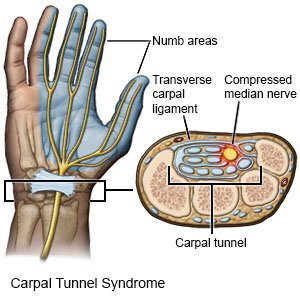Carpal Tunnel Syndrome: Understanding the Causes, Symptoms, Treatment, and Prevention
Definition
Carpal Tunnel Syndrome is a common condition that affects millions of people worldwide, and it is often associated with repetitive hand and wrist movements, such as typing or using a mouse.
As a physical therapist, it is important to understand the causes, symptoms, and treatments associated with this condition, as well as preventative measures that can be taken to reduce the risk of developing Carpal Tunnel Syndrome.
Causes of Carpal Tunnel Syndrome:
Carpal Tunnel Syndrome is caused by compression of the median nerve in the wrist.
The median nerve runs from the forearm to the hand, passing through a narrow space in the wrist called the carpal tunnel. The carpal tunnel is made up of bones and ligaments that form a tunnel-like structure. When the tissues in the carpal tunnel become swollen or inflamed, they can compress the median nerve, leading to pain and other symptoms associated with Carpal Tunnel Syndrome.


Some of the common causes of Carpal Tunnel Syndrome include repetitive hand and wrist movements, such as typing, using a mouse, or playing an instrument. Additionally, conditions such as diabetes, rheumatoid arthritis, and hypothyroidism can increase the risk of developing Carpal Tunnel Syndrome.
Symptoms of Carpal Tunnel Syndrome:
The symptoms of Carpal Tunnel Syndrome can vary from person to person, and they can range from mild to severe. Some of the most common symptoms include:
- Numbness or tingling in the hand and fingers.
- Pain in the hand and wrist.
- Weakness in the hand.
- Difficulty gripping objects.
- Sensation of pins and needles in the hand and fingers.
- Feeling of Pain Description.
The pain associated with Carpal Tunnel Syndrome is often described as a dull ache or a burning sensation that can radiate from the wrist to the fingers. Some people may also experience a shooting pain that can make it difficult to perform everyday tasks.
How can we make sure if it’s carpel tunnel or not?
If you suspect you may have Carpal Tunnel Syndrome, it is important to see a healthcare professional for an accurate diagnosis. Your doctor may perform a physical exam, and they may also order diagnostic tests, such as a nerve conduction study or an electromyogram (EMG) to confirm the diagnosis.
Exercises/ what to do:
If you have been diagnosed with Carpal Tunnel Syndrome, your physical therapist may recommend exercises to help relieve symptoms and strengthen the muscles in your hand and wrist.
Some of the exercises that may be recommended include wrist flexion and extension exercises, hand grip exercises, and finger stretches.
These exercises can be done at home between physical therapy sessions.
Physical Therapy for Carpal Tunnel Syndrome:
Physical therapy can be an effective treatment for Carpal Tunnel Syndrome. A physical therapist can help you identify the underlying causes of your symptoms and develop a customized treatment plan that may include exercises, manual therapy, and other modalities.
Manual therapy techniques, such as massage and mobilization, can help reduce inflammation and promote healing in the affected area.
Surgery for Carpal Tunnel Syndrome:
In some cases, surgery may be necessary to relieve the symptoms of Carpal Tunnel Syndrome. Surgery is typically recommended when conservative treatments, such as physical therapy, have failed to provide relief.
During surgery for Carpal Tunnel Syndrome, the ligaments that form the roof of the carpal tunnel are cut to relieve pressure on the median nerve. The procedure is typically done on an outpatient basis, and most people are able to return to their normal activities within a few weeks.
Conclusion
Carpal tunnel syndrome is a painful and often debilitating condition that can significantly impact your quality of life. However, with proper treatment and management, it is possible to find relief and improve your symptoms.
If you are experiencing any pain or discomfort in your hands or wrists, we encourage you to seek medical attention and take steps to prevent further damage. Remember to take frequent breaks, stretch your hands and wrists regularly, and be mindful of your posture and ergonomics when using technology or performing repetitive tasks.
We hope that this blog has provided you with valuable information and insight into carpal tunnel syndrome, and we urge you to prioritize your hand health and well-being.
Follow us on our Instagram page for a new video every day, tackling a new topic:
Link: https://instagram.com/physyour?igshid=YmMyMTA2M2Y=
